The battle of club icons continues, now going up against each other as club managers. It’s time for Manchester United vs Chelsea, Ole Gunnar Solskjær vs Frank Lampard in the Premier League. The two ended with the same number of points last season with Chelsea finishing behind Manchester United on goal difference. The tie remains imperative for the top four if not for chasing the title.
Manchester United have had some worrying performance this season in the Premier League. The team are yet to find their feet but the recent wins against Newcastle and PSG have bolstered their confidence.
Chelsea’s defence has been unsettling so far while the new acquisitions are yet to prove their worth. Frank Lampard would be looking for his first Premier League win against Solskjær’s United who managed to beat them in both the fixtures.
In this tactical analysis, we will examine the tactics of Manchester United and Chelsea used in this match. The analysis will further correlate to the match events and corresponding result.
Line-ups
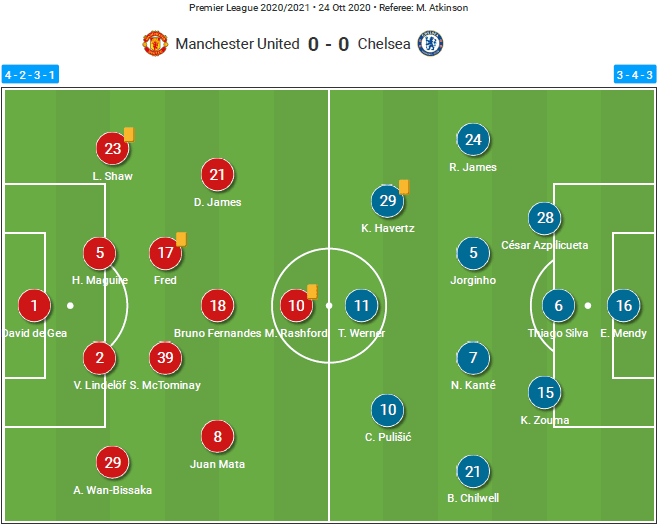
While many were expecting United to go for 3-5-2 after their win against PSG with that system, Solskjær stuck with the same starting eleven that won against Newcastle. The Spanish international David De Gea started in goal. Aaron Wan-Bissaka, Victor Lindelöf, Harry Maguire and Luke Shaw formed the back four. Scott McTominay and Fred played as the double pivots. Daniel James, Bruno Fernandes and Juan Mata played with Marcus Rashford up front. Alex Telles was surprisingly not in the squad after an impressive debut, Paul Pogba and Donny Van De Beek were again left on the bench.
Chelsea went with the 3-4-3 formation that helped them win against Manchester United in the FA cup last year. César Azpilicueta for Mason Mount is the only change from Sevilla’s game in the Champions League. New signing Edouard Mendy played between the sticks for Chelsea. Azpilicueta, Thiago Silva, and Kurt Zouma played in the back three. Reece James and Ben Chilwell played as the wing-backs and Jorginho along with N’Golo Kanté played in the midfield. Christian Pulisic, Timo Werner, and Kai Havertz played upfront. Hakim Ziyech is yet to start his first Premier League game.
Manchester United’s set-up to stop Chelsea’s progression
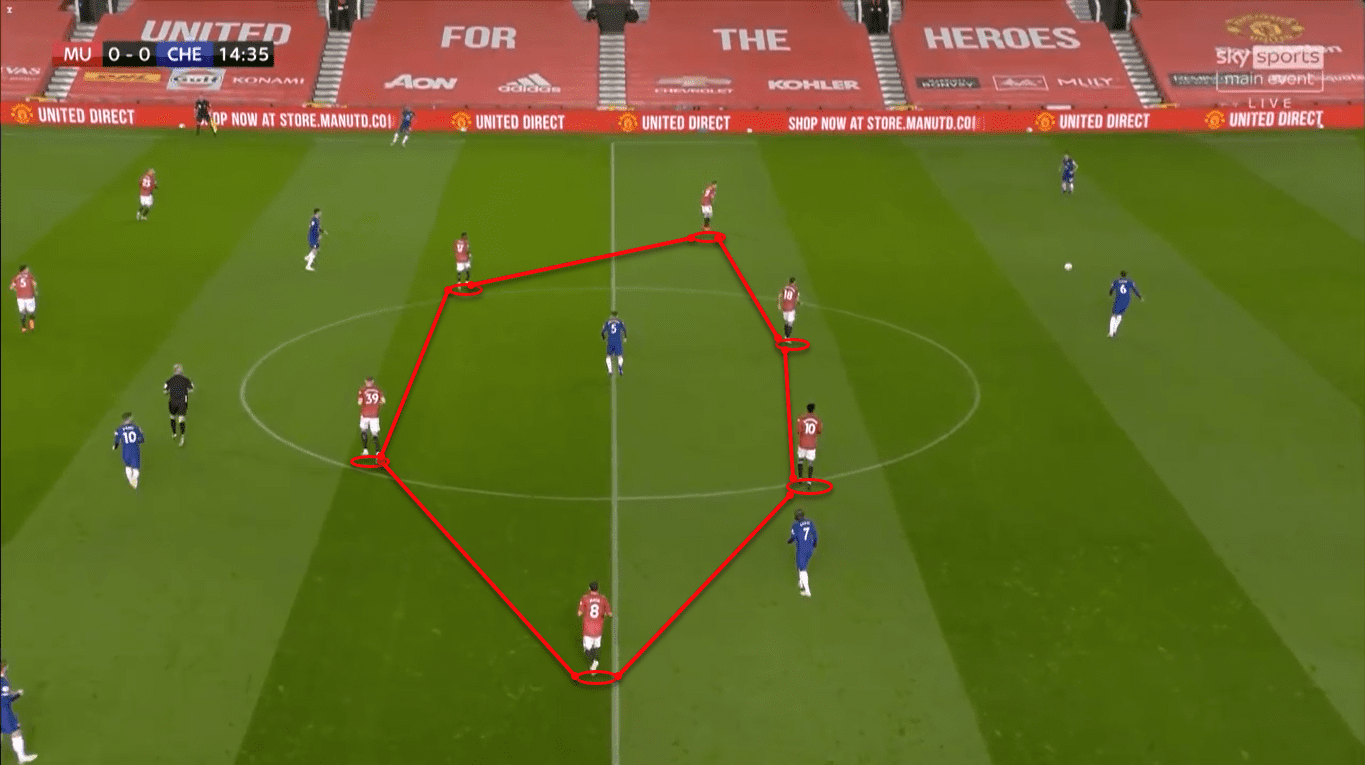
Chelsea was allowed a lot of time on the ball by Manchester United in the first half. The front two lines of defence of Manchester United executed the basic zonal marking with certain pressing triggers. They tried to form a central hexagon in 4-4-2 formation for the most part of the match. The shape adjusted with the ball while putting minimum pressure on the back three. James and Mata tried to prevent passes to Chelsea wing-backs from their wide centre-backs by making outside to inside curved runs. The idea was to either force a long ball or a back pass to the goalkeeper.
As we can see from the above picture, there was no particular man-marking on the field. The forwards tried to screen the pivots Kanté and Jorginho when the back-three had the ball. Fred and McTominay ensured good vertical distance to both ends of the line. Due to which they could support their back-line in case of a long ball and the forward line when Chelsea played line-breaking pass into the midfield. Havertz and Pulisic offered themselves as passing options by dropping between the lines. But they were not allowed time to turn or play a forward pass by United’s back-line.
Pressing triggers
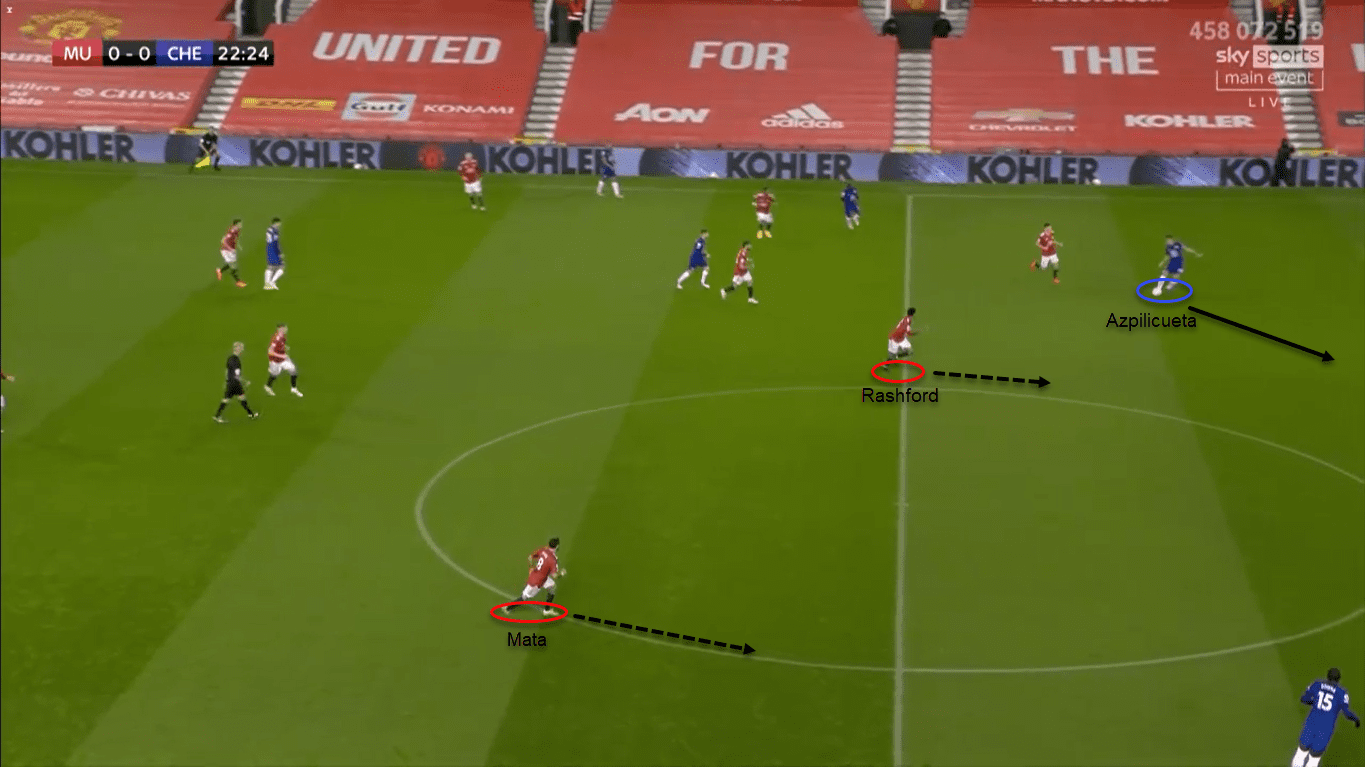
As we discussed before, there were a set of triggers when United would turn aggressive to press. Every time the Blues played a back pass, United’s frontline would look to apply pressure. The above picture shows how Rashford and Mata are already on the run as Azpilicueta is about to play the back pass to Silva. They specifically increased their intensity when Chelsea played it back their goalkeeper. Mendy almost put the ball in his net when he was pressed by United forwards. He completely miscued his pass to Silva and gave United a corner.
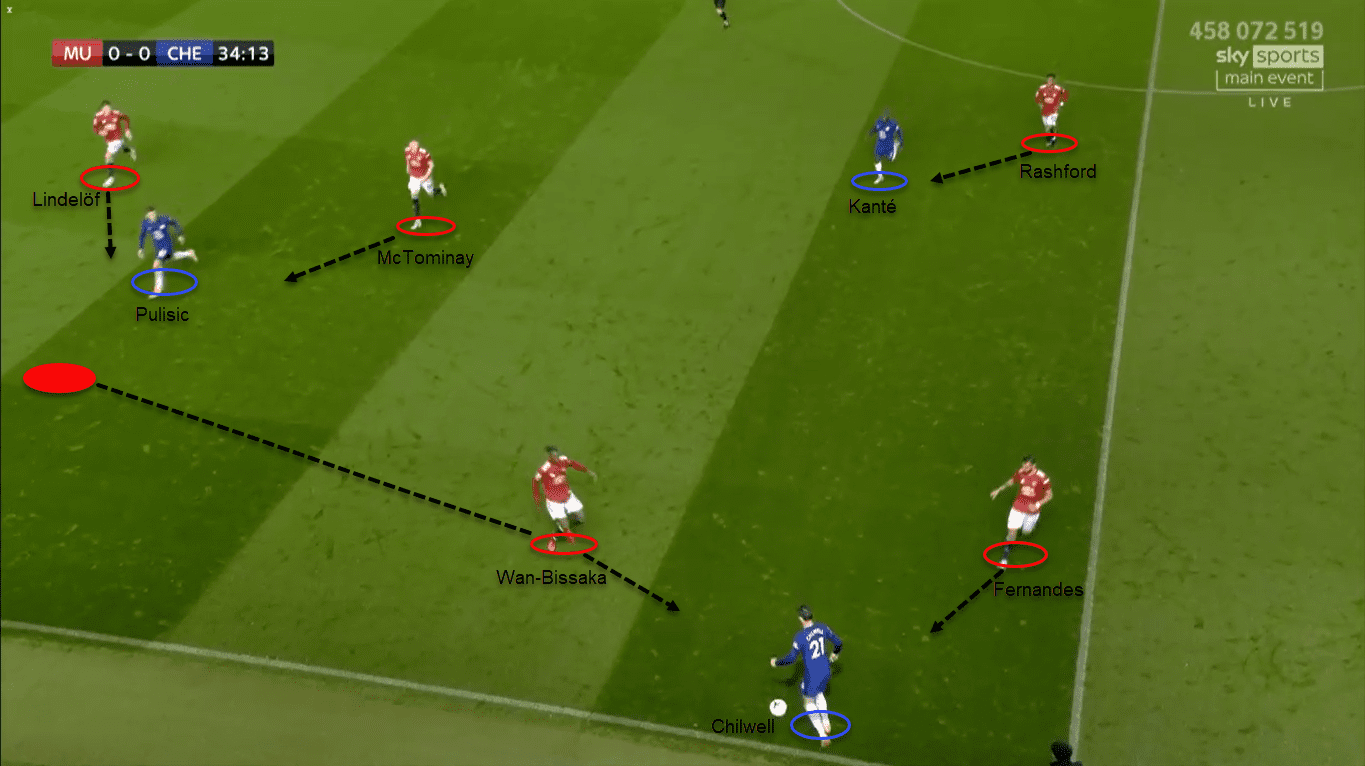
In case of United wingers not being able to prevent the pass to Chelsea wing-backs, United full-backs would immediately step out to press. As Manchester United was defending zonally at the top, Chelsea wing-backs were an easy outlet for progression at times due to ball circulation. However, due to United’s shape, they could easily trap Chelsea’s wing-backs by the sidelines. A United full-back (Wan-Bissaka) and winger (here Fernandes as he had swapped places with Mata) would collapse on the wing-back to cut the passing angles. Ball-side centre-back and central midfielder (Lindelof and McTominay) would cover the space left behind by the full-back and mark the Chelsea forward (Pulisic). Lastly the forward (Rashford) would cover the ball near pivot (Kanté). United would crowd the wings leaving not many options for the wing-backs but to go long or surrender possession.
In the second half, Manchester United wanted more possession of the ball. After the introduction of Pogba and Edinson Cavani, the triggers and the system to press remained the same but there was more desire and hunger to win the ball back. Recoveries per minute changed from 0.24 to 0.39 in the second half.
Chelsea’s attempts in attack
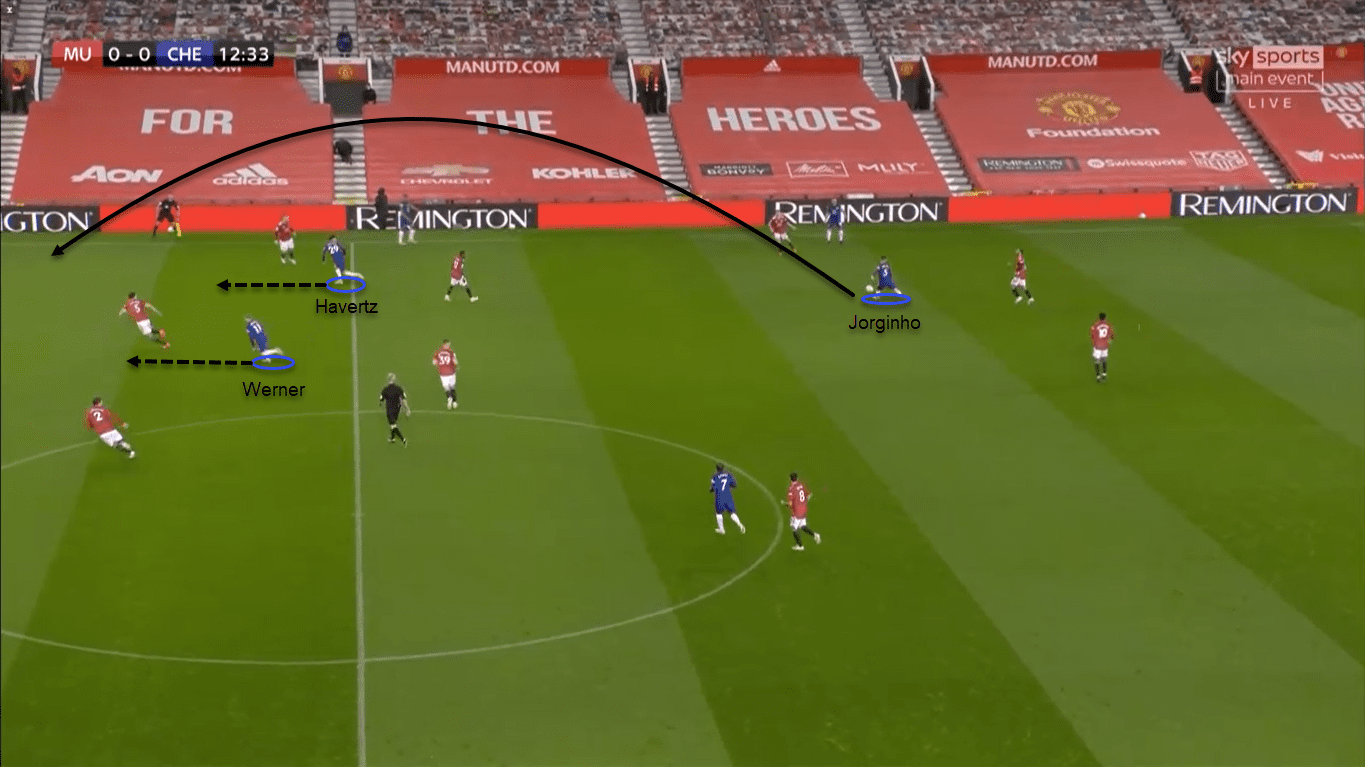
Werner loves to run behind the defence and receive the ball on his stride. Last week against Southampton, Jorginho played the ball over the Saints’ backline for Werner to receive and score his second goal of the game. Chelsea tried to use the same connection in this game as well. Whenever the pivots collected the ball in the midfield, they tried to release the forwards into the channel. These attempts were very few in numbers and United defenders read the move well before it happened. Maguire and Lindelöf positioned well against Chelsea’s front-line, it is evident that they were aware of the threat as they were already running back when Jorginho got the ball. United’s back-line maintained a fair distance from the forwards to not get caught against their pace and hence limited Chelsea’s chances.
Missing key details
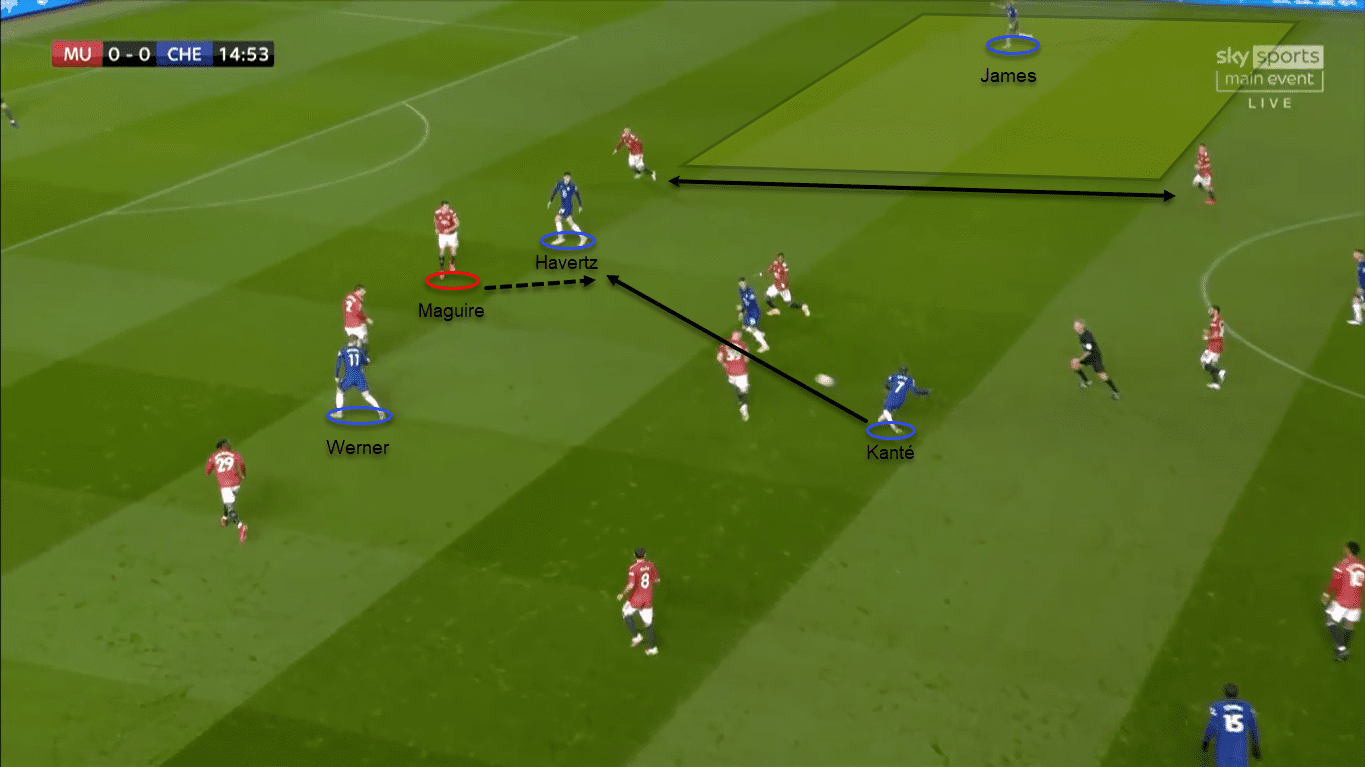
Chelsea was very direct in terms of getting the ball to their forwards. Here Kanté was given some freedom to pick a pass at his ease as Chelsea successfully bypassed United’s first line of defence. Havertz and Werner had compressed the United back-line due to their positioning in channels. Kanté tried to play a through ball to Havertz in an attempt to make the most of the situation. Maguire read the move and intercepted the pass in time. United defenders were strong and solid at the back. Maguire and Wan-Bissaka had a notable impact in terms of perusing the game, they made 10 and 16 interceptions respectively.
While Chelsea were restricted through the middle by United’s backline, it is worth noticing the space offered by them on the flanks, something that Kanté totally missed. This is a sign of either a rigid approach of the team or lack of awareness by the player. The space in which Reece James was in has been exploited by many other teams against United. Unfortunately for Chelsea, they didn’t find themselves in such situations in abundance where they could have tried something different.
Structure of forwards
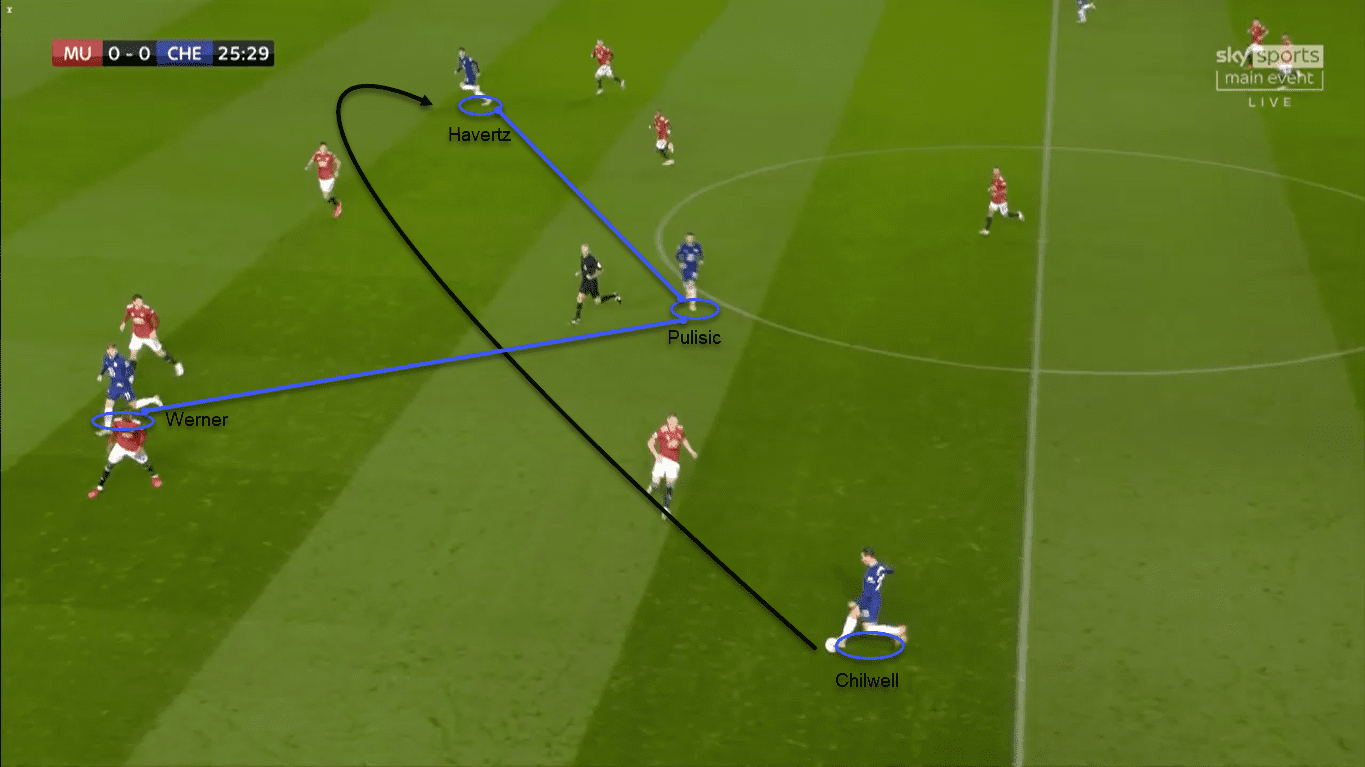
The Blues also had a few opportunities in positive transitions. They have the ability to play it out from pressure situations after regaining possession. As United overloaded one side to attack (explained further), on regaining possession Chelsea could switch the play to transition forward. The front three kept interchanging positions throughout the game. While Lampard is yet to find the best positional combination for his forwards, the structure used in this match caters to each of the forward’s abilities.
Werner demonstrated his threat off the left during his time at RB Leipzig. Havertz is versatile and is capable of playing in multiple positions. He has been used as a right midfielder, centre-forward and as an attacking midfielder at Bayer 04 Leverkusen. Pulisic has the potency to carry the ball and dribble through a number of players. Therefore he tends to drop off and offer a short passing option in the centre. Havertz and Werner’s positioning ensured that the United centre-backs couldn’t track him. Although the structure was interesting, Chelsea failed to capitalise with it. On this occasion, Havertz couldn’t put the precise weight on his pass to Werner due to which they squandered the opportunity. Pulisic was underutilized in such situations but presents promising ideas to explore in the future.
James’ impressive role as a wing-back
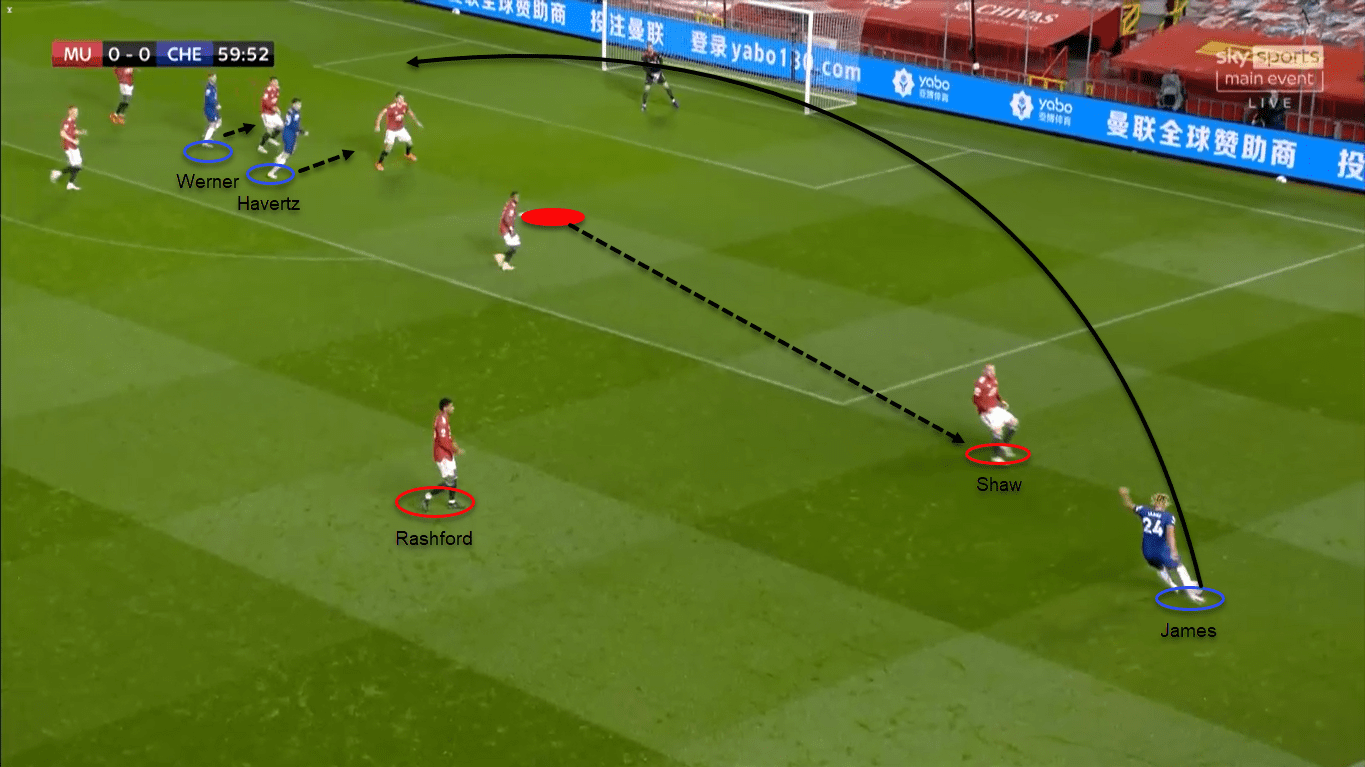
Reece James was heavily involved in the later stages of the games. Chelsea attempted 12 crosses in the game out of which six came from James. He delivered some cracking balls in the box and made sure that United defence acted upon it. Pulisic came very close to scoring from his late run inside the box to meet the cross from James. The overall performance of the forwards was quite underwhelming. Nobody from the forwards other than Pulisic attempted a single shot on goal. The team collectively took six shots out of which tested De Gea only on two occasions with the total xG of just 0.25.
Chelsea’s pressing and counter-pressing
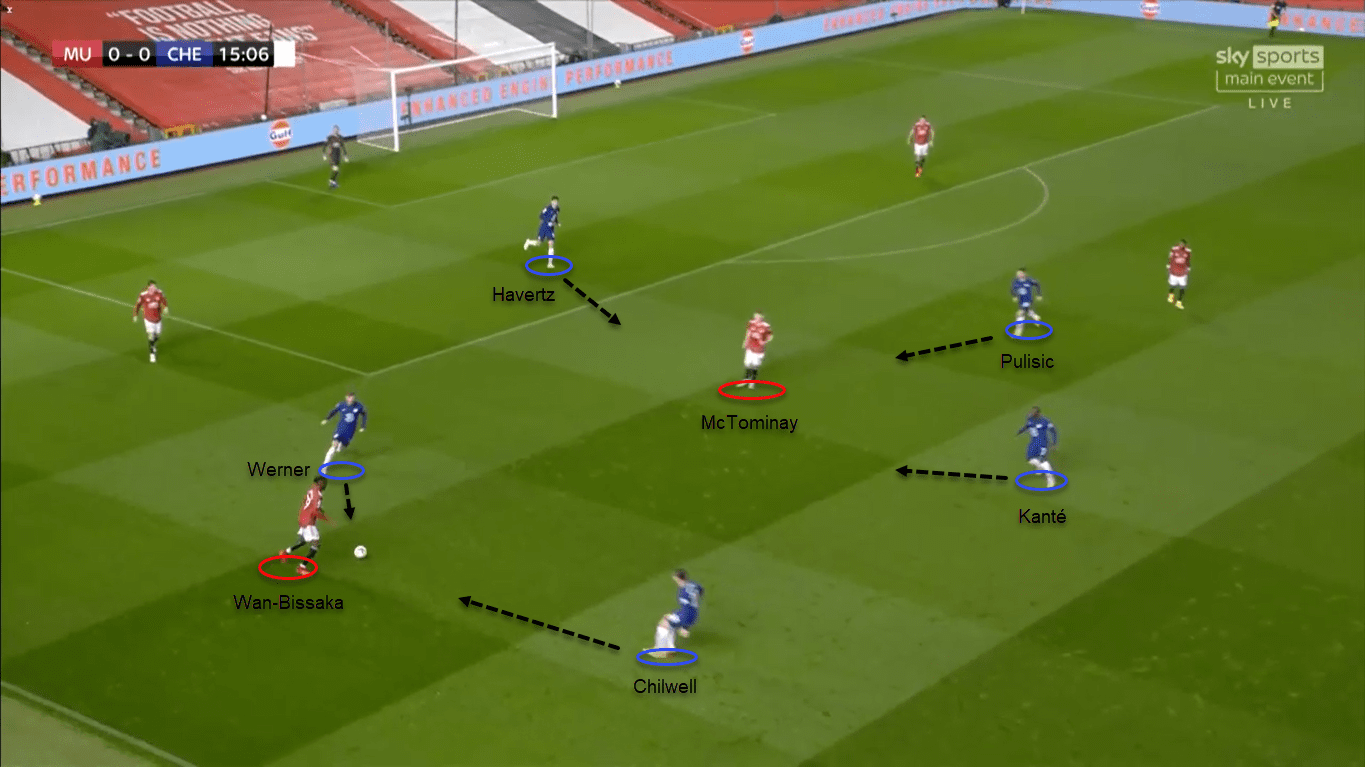
The Blues lined up in a 5-2-3 out of possession. They established control on the central channel when United had possession. When De Gea started the play from the back, Chelsea’s front three stayed compact to eliminate United’s double pivot McTominay and Fred. As the central corridor was blocked, Lindelöf and Maguire sought support from the full-backs. Chilwell and James were prepared to press as soon as the opposition centre-back in their vertical half had the ball. They were joined by Jorginho/Kanté depending on which side the ball is. The far side Chelsea forward would invert into the central channel.
This is how they focused on controlling the space around the ball carrier and executed space-oriented zonal pressing. A similar situation occurred on the right side when Fred took a poor touch on the ball. He was surrounded by six Chelsea players and Pulisic was quick to react and gather the loose ball. He carried it forward to take a shot from the outside of the box, only inches away from the far post.
Tactical alteration for progression
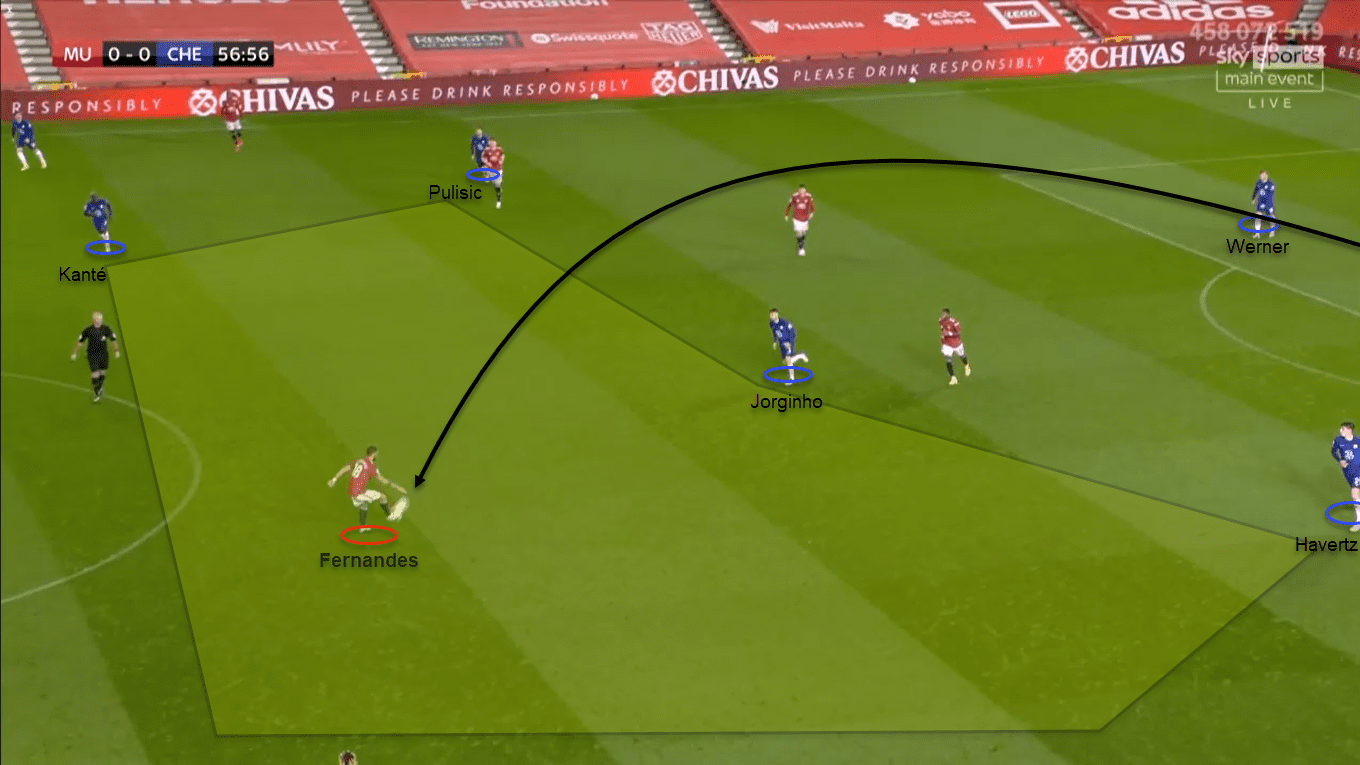
United’s 4-2-3-1 shape in build-up faced many troubles in the first half. Solskjær made a few changes to facilitate ball progression through the press. As Mata liked to drift inside in attack, he was asked to do so from the build-up itself in the second half. Wan-Bissaka pushed higher up on the right and McTominay settled in his place during the build-up, this made it look like 4-1-4-1 formation. Essentially it was done to stretch to the front three to create more space in the centre.
Moreover, Chelsea liked to push their ball near pivot to block United’s pivot during build-up. Hence their shape would often look like 5-1-3-1. This meant that Jorginho/Kanté were up against two attacking midfielders, Mata and Fernandes. The unmarked midfielder was supposed to be marked by one of the centre-backs, ie; Zouma will mark Mata if Jorginho is marking Fernandes while Kanté is supporting the front-line or Azpilicueta would press Fernandes if Kanté is marking Mata and Jorginho is supporting the front-line.
Solskjær tried to isolate Fernandes as Zouma is exceptional at winning aerial duels. Therefore Mata dragged Kanté wide when Jorginho marked United’s pivot. To make sure Azpilicueta didn’t get involved, Rashford and James doubled up on the left side higher up the pitch. Fernandes had tremendous time and space to receive the pass from De Gea. He then found Rashford with a quality pass, although Silva covered well to delay the action from Rashford. United followed the same drill when Pogba came on, he has a natural aerial superiority against Chelsea players on the left side of the pitch.
Stopping counter-attacks
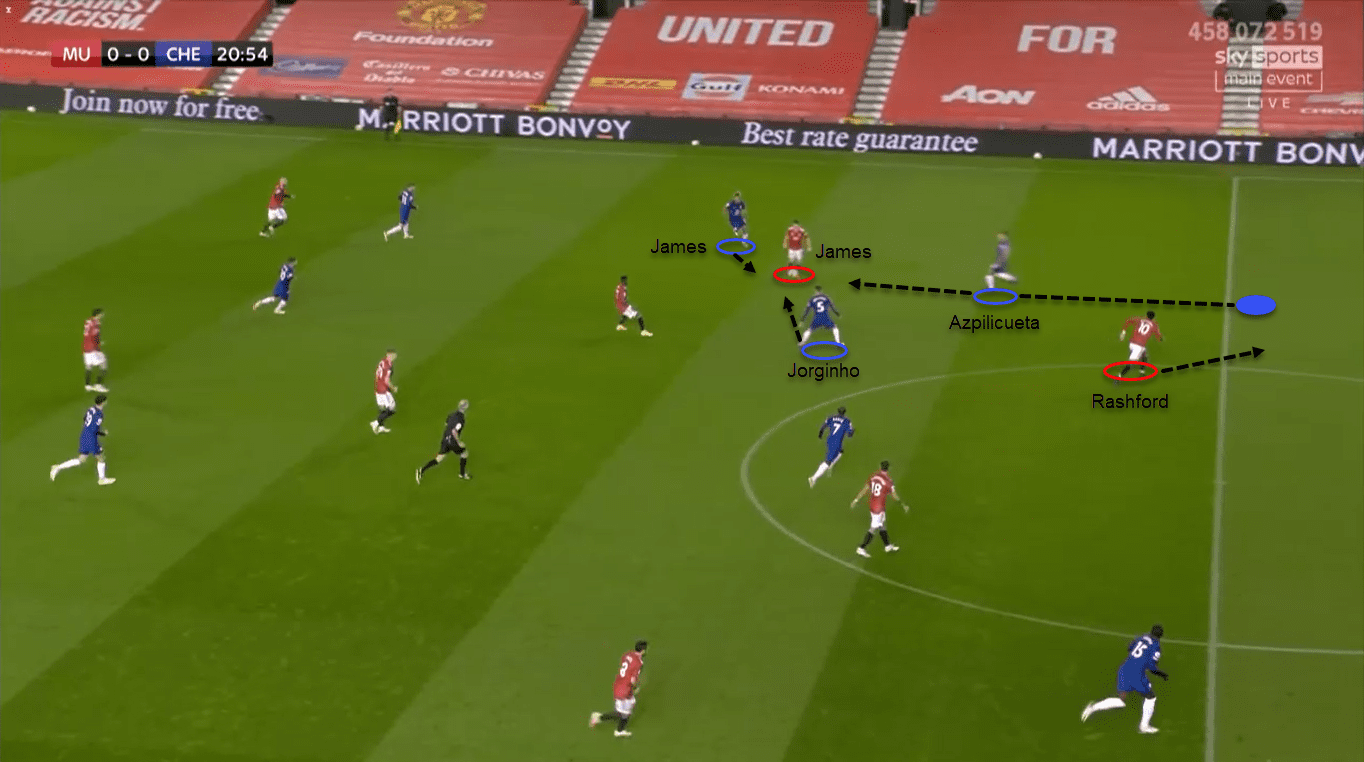
United absorbed pressure to convert it into counter-attacks. Chelsea had to be aware of that and took needful measures to try and stop it. On losing possession, the ball near centre-back would immediately step out to press and block the forward pass. He was supported by the ball near centre-midfielder blocking the diagonal/lateral angle. The wing-back too would come infield to add pressure on the ball carrier. Chelsea tried to cease all progressive movements and passing. The intention was to not always win the ball but to just force a back pass. United didn’t have many options in runners up front. Other than Rashford, Daniel James couldn’t produce much in transitions as he was watched carefully by Reece James and Azpilicueta.
Manchester United in attack
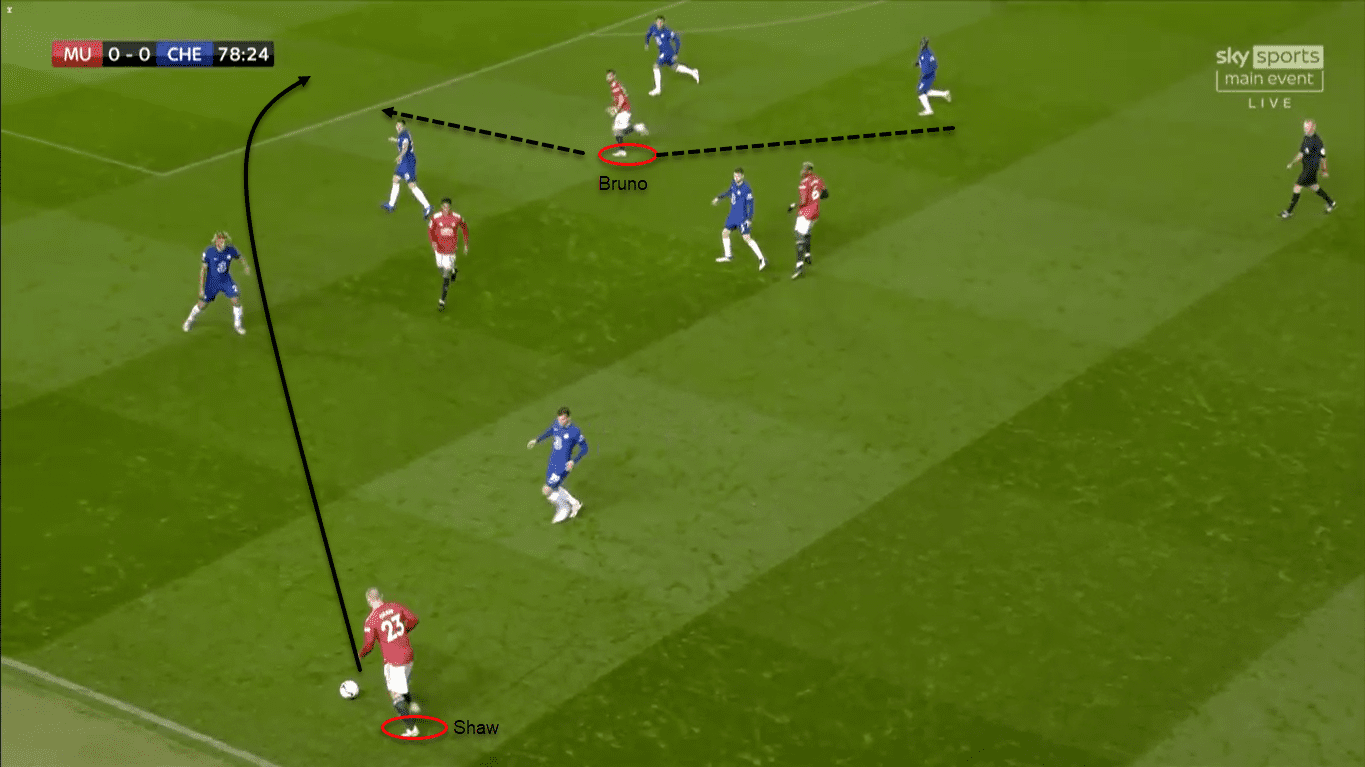
The Red Devils attacked in a 4-1-4-1 or 3-2-4-1 formation. Wan-Bissaka moved forward to let Mata drift inside. Mata and Fernandes played close to each other and James played on the left wing with Rashford top. Fernandes has a knack of finding space and combing with his players close to the ball; United, therefore, overloads one side of the pitch.
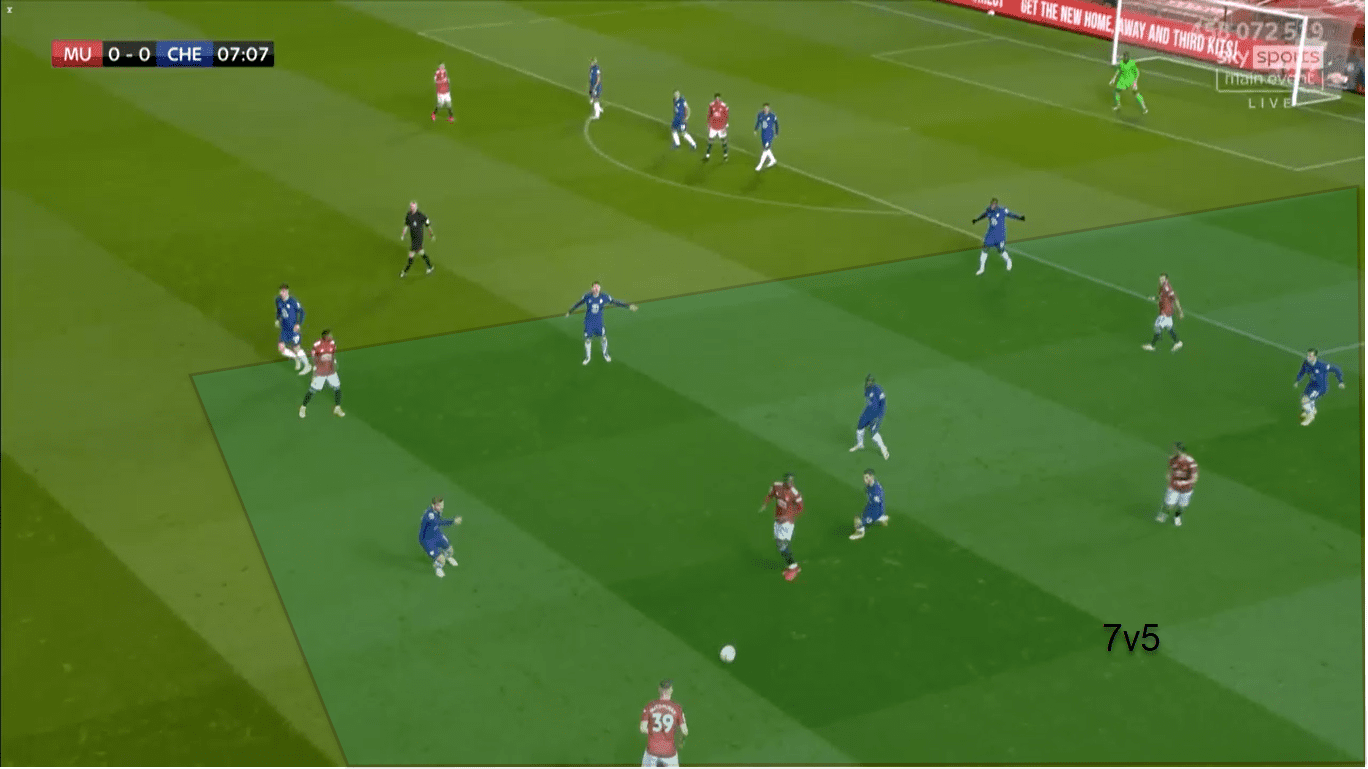
Chelsea players worked their socks off to nullify the overload on the flanks. The five players ahead of the backline defended very narrowly to make sure United don’t have a numerical advantage. United struggled to play through the numbers. In absence of Pogba, a player with a good radius of passing, they would go all the way to the back-line to switch the play. This would give Chelsea enough time to shift their bodies across the pitch.
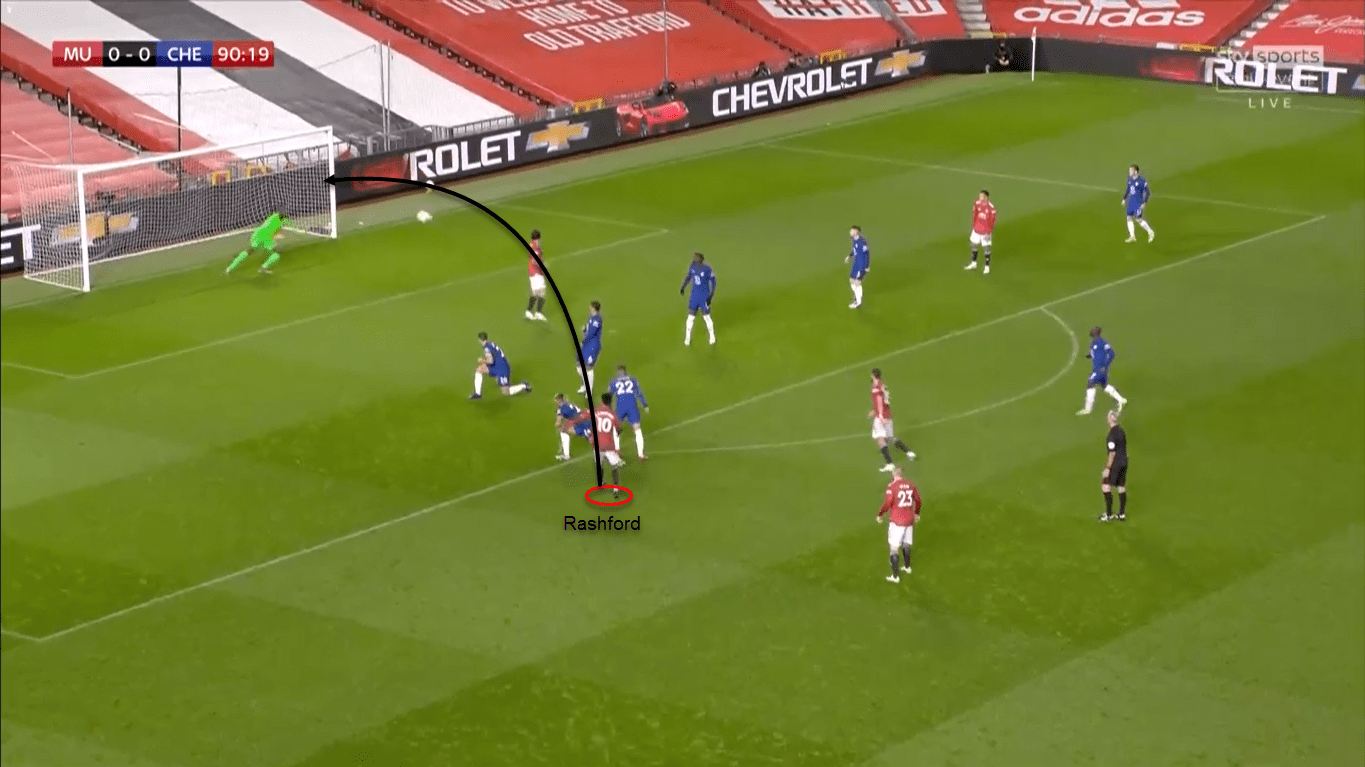
United had to work with quick one-twos and combination play to breach past the first two lines of Chelsea’s defence. Yet the back-line of five was still guarding the final third. United players tried to cut inside and make horizontal runs but were closed down quickly. They were forced to play it back then and shoot from distance. The Red Devils took 11 shots in the game out of which seven were from the outside of the box. All the four shots on target were from the outside of the box. Mendy produced a phenomenal save as he denied Rashford from a clear goalscoring opportunity.
Conclusion
Not all matches need a ton of goals to fall under the category of entertaining. Despite the 0-0 result, there’s so much to appreciate and enjoy from both the sides. A stellar defensive display from both the sides to hold off each other. Chelsea is finally looking to settle their defence with consistency now. They still have issues related to their attack to address. The Red Devils got their first clean-sheet in the Premier League. But United failed to win at home for the fifth consecutive time in the Premier League. Both the clubs need to resolve their negatives to ensure the top-four finish.





Comments